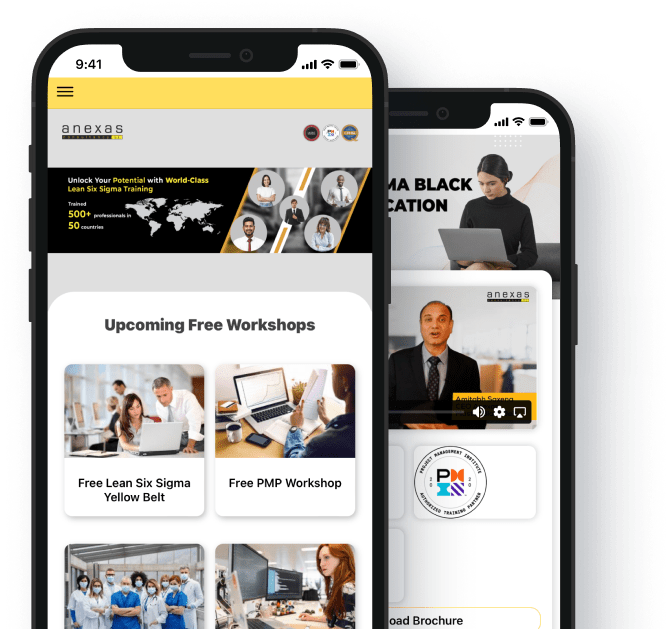The History and Evolution of Lean Six Sigma: From Motorola to Modern Industry
Introduction to the history and evolution of Lean Six Sigma
In today’s rapidly evolving industrial landscape, the significance of process improvement methodologies cannot be overstated. These methodologies act as the backbone of organizational excellence, ensuring streamlined operations, enhanced efficiency, and consistent quality. At the forefront of these methodologies is Six Sigma, a pioneering approach that traces its roots back to the early stages of the six sigma history timeline. The evolution of Six Sigma began with the development of foundational frameworks such as the PDCA cycle and Statistical Process Control (SPC), laying the groundwork for what would become a revolutionary paradigm in process optimization. Concurrently, the history of lean six sigma emerged as a fusion of Lean principles—focused on waste reduction and value creation—and Six Sigma’s data-driven, defect-reduction techniques. This amalgamation gave birth to Lean Six Sigma, a holistic methodology that synergizes the strengths of both approaches to deliver unparalleled results. For those unfamiliar with its intricacies, understanding what is Lean Six Sigma methodology becomes imperative. Essentially, it encompasses a structured approach to eliminating waste (Lean) and reducing variability (Six Sigma), thereby driving improvements across diverse operational facets. As we delve deeper into the evolution of Lean Six Sigma, one can observe its transformative impact across various sectors, shaping organizational cultures and setting new benchmarks for excellence. Whether it’s exploring what is Lean training for aspiring professionals or delving into the nuances of the Lean Six Sigma history timeline, the journey underscores a relentless pursuit of perfection and continuous improvement. Thus, as we embark on this exploration titled “The History and Evolution of Lean Six Sigma,” we aim to unravel the rich tapestry of its origins, milestones, and enduring legacy in shaping modern industry.
The Roots of Lean and Six Sigma
Six Sigma
Origin and early applications
- Introduction to Six Sigma’s Roots: Delve into the historical context that led to the development of Six Sigma. Highlight the prevalent quality management challenges faced by industries in the late 20th century.
- Emergence at Motorola: Discuss how Motorola became the pioneering organization to formally adopt and implement Six Sigma, driven by the need to reduce defects in their manufacturing processes.
- Spread Across Industries: Explore the rapid adoption of Six Sigma beyond manufacturing, into sectors like healthcare, finance, and services, showcasing its versatility and applicability.
Key figures: Bill Smith, Mikel Harry, and others
- Bill Smith: The Engineer Behind Six Sigma: Detail the contributions of Bill Smith, an instrumental figure at Motorola who recognized the potential of statistical methods in quality improvement.
- Mikel Harry: Architect and Advocate: Provide an overview of Mikel Harry’s role in shaping Six Sigma’s methodologies and promoting its principles globally.
- Other Influential Figures: Highlight additional contributors and thought leaders who played significant roles in refining and expanding Six Sigma’s concepts and applications.
The philosophy behind Six Sigma: Defining, measuring, analyzing, improving, and controlling processes.
- The DMAIC Framework: Introduce the DMAIC (Define, Measure, Analyze, Improve, Control) methodology as the cornerstone of Six Sigma, explaining each phase in detail.
- Holistic Approach to Process Improvement: Discuss how Six Sigma emphasizes a comprehensive approach, focusing not only on defect reduction but also on enhancing overall process efficiency and customer satisfaction.
- Integration of Statistical Tools: Highlight the importance of statistical tools and techniques in Six Sigma, showcasing how data-driven decision-making drives tangible improvements and sustainable results.
- Cultural Transformation: Emphasize the cultural shift fostered by Six Sigma, where continuous improvement becomes ingrained in the organizational mindset, fostering a culture of excellence and innovation.

Lean Thinking
Origins in Toyota Production System (TPS) and the work of Taiichi Ohno.
- Historical Context: In the aftermath of World War II, Japan faced a challenging socio-economic landscape marked by resource constraints, high variability in customer demand, and intense competition. Within this milieu, Toyota emerged as a beacon of innovation, pioneering a novel approach to manufacturing that would later be recognized as Lean Thinking. The Toyota Production System (TPS) was not merely a set of tools and techniques but a holistic philosophy grounded in principles of efficiency, continuous improvement, and respect for people.
- Taiichi Ohno: The Architect of TPS: Taiichi Ohno, a visionary engineer and executive at Toyota, played a pivotal role in conceptualizing and refining the TPS. Ohno’s insights into the nuances of production processes led to the development of groundbreaking methodologies, including the Just-In-Time (JIT) production system and the concept of eliminating waste, known as Muda. His emphasis on empowering frontline workers, fostering a culture of problem-solving, and relentlessly pursuing operational excellence laid the foundation for Lean Thinking’s core tenets.
- Significance in the Six Sigma History Timeline: While Six Sigma and Lean Thinking emerged from distinct historical contexts and evolved independently, their trajectories intersect in the pursuit of operational excellence. Understanding the distinct origins and evolution of Lean Thinking within the broader six sigma history timeline provides a nuanced appreciation of their complementary nature, offering organizations a comprehensive toolkit for addressing diverse operational challenges and opportunities.
Core principles: Value, value stream, flow, pull, and perfection.
- Value Creation: At the heart of Lean Thinking lies the principle of ‘Value,’ emphasizing the critical importance of understanding and aligning with customer needs and expectations. By focusing on value creation, organizations can streamline processes, eliminate non-value-added activities, and deliver products or services that resonate with customers, thereby fostering loyalty and driving sustainable growth.
- Value Stream Mapping: The ‘Value Stream’ concept transcends traditional functional silos, providing a holistic view of end-to-end processes. Value Stream Mapping, a core Lean tool, enables organizations to visualize workflow, identify bottlenecks, and optimize processes to enhance efficiency, reduce lead times, and enhance customer value.
- Flow and Pull Systems: ‘Flow’ and ‘Pull’ principles advocate for the seamless, uninterrupted movement of products or services through the value stream, driven by actual customer demand. By implementing Pull systems, organizations can synchronize production with demand, minimize inventory, and enhance responsiveness, thereby fostering operational flexibility and adaptability.
- Perfection as a Continuous Journey: In Lean Thinking, ‘Perfection’ is not a static state but a dynamic, aspirational journey characterized by relentless pursuit of excellence. By embracing a mindset of continuous improvement, organizations can challenge the status quo, drive innovation, and cultivate a culture of excellence that transcends boundaries and fosters sustainable success.
The focus on waste elimination and continuous improvement.
- Elimination of Waste: Lean Thinking’s unequivocal focus on waste elimination, encapsulated in the concept of Muda, reflects its commitment to maximizing value and optimizing resource utilization. By categorizing and systematically addressing seven types of waste—ranging from overproduction and inventory excess to defects and underutilized talent—organizations can unlock hidden efficiencies, reduce costs, and enhance overall performance.
- Kaizen and Continuous Improvement: ‘Kaizen,’ a cornerstone of Lean Thinking, embodies the ethos of continuous improvement and incremental enhancement. By engaging employees at all levels, fostering cross-functional collaboration, and leveraging data-driven insights, organizations can cultivate a culture of Kaizen that empowers teams, accelerates innovation, and drives sustainable growth.
- Integration with Six Sigma: The convergence of Lean Thinking and Six Sigma, commonly referred to as Lean Six Sigma, represents a synthesis of Lean’s focus on waste elimination, flow optimization, and continuous improvement with Six Sigma’s analytical rigor, data-driven decision-making, and defect reduction capabilities. This integrated approach amplifies the impact of process improvement initiatives, enhances organizational resilience, and fosters a holistic framework for achieving operational excellence in today’s complex, dynamic business environment.
The Emergence of Lean Six Sigma
Motorola’s Contribution
Introduction to the Motorola case study and the birth of Six Sigma
- Historical Context: Delve into the manufacturing landscape of the late 20th century, highlighting the prevalent quality control challenges faced by organizations, including Motorola. Detail the imperative need for a systematic approach to address these issues, laying the groundwork for the emergence of Six Sigma.
- Pioneering Initiatives: Chronicle Motorola’s proactive stance in championing quality improvement initiatives, culminating in the formalization of Six Sigma. Emphasize the organization’s commitment to redefining quality benchmarks and fostering a culture of continuous improvement.
- Significance in the Six Sigma History Timeline: Position Motorola’s pioneering efforts within the broader context of the six sigma history timeline, underscoring its role as a seminal moment that catalyzed the methodology’s evolution and global proliferation.
How Motorola combined statistical methods with lean principles
- Integration of Methodologies: Provide a nuanced exploration of how Motorola amalgamated statistical methods, characterized by rigorous data analysis and process control, with Lean principles, emphasizing waste reduction and value enhancement. Illustrate the synergies between these approaches, highlighting their complementary nature in driving holistic process improvement.
- Holistic Approach: Expound on the comprehensive nature of Motorola’s approach, where the fusion of statistical rigor with Lean’s operational excellence principles created a robust framework for addressing multifaceted challenges. Emphasize the organization’s innovative synthesis of these methodologies, setting a precedent for subsequent implementations.
- Contribution to the Evolution of Lean Six Sigma: Chart Motorola’s instrumental contributions to the evolution of Lean Six Sigma, elucidating its role in shaping methodologies, refining tools, and fostering best practices. Highlight the organization’s pivotal influence on Lean Six Sigma’s conceptual development and practical application.
- Training and Skill Development: Illuminate Motorola’s strategic emphasis on training and skill development, elucidating how the organization cultivated a cadre of adept practitioners proficient in Lean Six Sigma methodologies. Discuss the establishment of comprehensive training programs, knowledge transfer initiatives, and organizational learning mechanisms that fortified its implementation capabilities.
Early successes and adoption across the industry
- Demonstrable Results: Showcase the tangible outcomes realized by Motorola through the rigorous application of Six Sigma, delineating notable improvements in product quality, process efficiency, and customer satisfaction metrics. Present compelling case studies and performance metrics that attest to the transformative impact of the methodology.
- Industry-wide Impact: Examine the ripple effect triggered by Motorola’s success stories, exploring how its achievements galvanized interest in Six Sigma across diverse industry sectors. Chart the methodology’s diffusion, highlighting pivotal milestones, seminal implementations, and organizations that championed its adoption.
- Benchmark for Excellence: Position Motorola as a paragon of operational excellence, underscoring its innovative practices, exemplary outcomes, and enduring commitment to quality improvement. Emphasize the organization’s role as a benchmark that set new industry standards and catalyzed a paradigm shift in quality management practices.
- Legacy in the History of Six Sigma: Conclude by reaffirming Motorola’s indelible legacy in the history of Six Sigma, encapsulating its pioneering spirit, transformative contributions, and lasting influence on the methodology’s evolution. Reflect on the organization’s enduring impact, celebrating its role as a trailblazer that illuminated the path for subsequent generations of practitioners and organizations.

Integration of Lean and Six Sigma
The complementary nature of the two methodologies
- Historical Context: The evolution of Six Sigma, rooted in statistical methods and rigorous data analysis, and Lean Thinking, anchored in waste elimination and value creation, emerged from distinct historical contexts and organizational imperatives. While Six Sigma’s origins can be traced back to the development of the PDCA cycle and Statistical Process Control (SPC), Lean Thinking evolved from the Toyota Production System (TPS) and Taiichi Ohno’s seminal contributions. Despite their unique trajectories, these methodologies converged in their shared objective of enhancing organizational performance, fostering a culture of continuous improvement, and delivering superior customer value.
- Complementary Principles: Explore the foundational principles of Six Sigma, emphasizing defect reduction, process optimization, and data-driven decision-making, and juxtapose them with Lean’s focus on waste elimination, flow optimization, and value stream enhancement. Highlight how these principles, while distinct in their emphasis, are inherently complementary, providing organizations with a comprehensive framework for addressing multifaceted operational challenges and opportunities.
- Symbiotic Relationship: Illustrate the symbiotic relationship between Lean and Six Sigma, underscoring how their integration—commonly referred to as Lean Six Sigma—enables organizations to leverage the strengths of both methodologies. Discuss how this synergistic approach fosters a holistic, integrated framework for achieving operational excellence, driving innovation, and sustaining competitive advantage in today’s dynamic business landscape.
The concept of “Lean Six Sigma” and its foundational principles
- Emergence of Lean Six Sigma: Chart the evolution of Lean Six Sigma, tracing its origins and development within the broader six sigma history timeline and the history of Lean Six Sigma. Discuss how organizations began to recognize the complementary nature of Lean and Six Sigma methodologies and the transformative potential of their integration.
- Foundational Principles: Define and elaborate on the foundational principles of Lean Six Sigma, encompassing elements of waste elimination, defect reduction, value creation, and continuous improvement. Explore how these principles provide a robust framework for process optimization, organizational alignment, and customer-centric innovation.
- Methodological Framework: Provide an overview of what is Lean Six Sigma methodology, outlining its key components, stages, and tools. Discuss how Lean Six Sigma’s structured, data-driven approach empowers organizations to identify root causes, implement targeted interventions, and monitor performance metrics to drive sustainable improvements and achieve desired outcomes.
Benefits of combining Lean and Six Sigma: Speed, efficiency, and quality.
- Enhanced Speed and Responsiveness: Discuss the tangible benefits organizations can realize by combining Lean and Six Sigma methodologies, emphasizing accelerated process cycles, reduced lead times, and enhanced agility. Illustrate how Lean Six Sigma enables organizations to streamline operations, eliminate bottlenecks, and respond swiftly to market dynamics and customer demands, fostering a competitive edge in today’s fast-paced business environment.
- Optimized Efficiency and Resource Utilization: Explore how the integration of Lean and Six Sigma enables organizations to optimize resource utilization, minimize waste, and enhance overall operational efficiency. Discuss the synergistic benefits of Lean’s focus on waste elimination and flow optimization, coupled with Six Sigma’s emphasis on data-driven decision-making and process optimization, in driving tangible improvements in productivity, cost-effectiveness, and resource allocation.
- Superior Quality and Customer Satisfaction: Highlight the profound impact of Lean Six Sigma on product and service quality, emphasizing defect reduction, process standardization, and customer-centric innovation. Discuss how Lean Six Sigma’s relentless pursuit of perfection, coupled with its structured problem-solving approach, fosters a culture of excellence, customer satisfaction, and continuous improvement, positioning organizations to deliver unparalleled value and achieve sustainable growth.
Expansion and Adoption in Various Industries
Beyond Manufacturing: Lean Six Sigma in Services
Challenges and opportunities in service industries.
- Distinctive Nature of Service Operations: Delve into the unique characteristics of service industries, emphasizing the intangible nature of services, variability in service delivery, and the critical role of customer interactions. Discuss how these distinctive features present both challenges and opportunities for implementing Lean Six Sigma methodologies, necessitating tailored approaches and innovative solutions to drive operational excellence.
- Complexity and Variability: Explore the inherent complexity and variability associated with service operations, highlighting the diverse range of processes, customer touchpoints, and stakeholder interactions that characterize service delivery. Discuss the implications of these factors on service quality, efficiency, and customer satisfaction, underscoring the need for robust methodologies, structured problem-solving approaches, and data-driven insights to navigate the intricacies of service environments.
- Strategic Imperatives: Outline the strategic imperatives driving the adoption of Lean Six Sigma in service industries, including the pursuit of cost efficiency, enhancement of service quality, and differentiation in competitive markets. Emphasize how Lean Six Sigma enables organizations to streamline processes, optimize resource allocation, and foster a culture of continuous improvement, positioning them to achieve sustainable growth and long-term success in dynamic service landscapes.
Case studies: Healthcare, finance, and IT
- Healthcare: Explore the application of Lean Six Sigma in healthcare settings, highlighting its transformative impact on patient care, operational efficiency, and clinical outcomes. Discuss specific case studies where healthcare organizations have leveraged Lean Six Sigma methodologies to reduce medical errors, enhance process efficiency, and improve patient satisfaction, underscoring its potential to drive significant improvements in healthcare delivery and organizational performance.
- Finance: Examine the role of Lean Six Sigma in the finance sector, focusing on its application in banking, insurance, and investment management. Discuss how financial institutions have utilized Lean Six Sigma to streamline operations, optimize risk management processes, and enhance customer experiences, illustrating its capacity to drive operational excellence, regulatory compliance, and competitive differentiation in the highly regulated and rapidly evolving financial services landscape.
- IT: Delve into the application of Lean Six Sigma in the IT sector, emphasizing its role in software development, IT service management, and infrastructure operations. Discuss how IT organizations have adopted Lean Six Sigma methodologies to improve software quality, accelerate product delivery cycles, and enhance IT service performance, illustrating its potential to drive innovation, agility, and customer value in technology-driven industries.
Customizing Lean Six Sigma for service environments
- Adapting Lean Six Sigma Principles: Explore the nuances of customizing Lean Six Sigma methodologies for service environments, emphasizing the importance of adapting Lean Six Sigma principles, tools, and techniques to align with the unique characteristics and requirements of service operations. Discuss specific strategies for tailoring Lean Six Sigma initiatives to address service-specific challenges, optimize customer interactions, and enhance overall service delivery.
- Customer-Centric Approach: Highlight the importance of adopting a customer-centric approach in service industries, emphasizing the need to align Lean Six Sigma initiatives with customer expectations, preferences, and feedback. Discuss how organizations can leverage Lean Six Sigma methodologies to enhance customer experiences, foster loyalty, and drive sustainable growth by delivering services that consistently meet or exceed customer expectations.
- Organizational Culture and Change Management: Explore the critical role of organizational culture and change management in the successful implementation of Lean Six Sigma in service environments. Discuss strategies for fostering a culture of continuous improvement, empowering employees, and overcoming resistance to change, emphasizing the importance of leadership engagement, stakeholder buy-in, and effective communication in driving successful Lean Six Sigma transformations in service industries.

Global Spread and Adaptation
International adoption and localization of Lean Six Sigma.
- Global Dissemination: Trace the global spread of Lean Six Sigma, highlighting its adoption across diverse industries and regions worldwide. Discuss the factors driving international interest in Lean Six Sigma, including the pursuit of operational excellence, competitive differentiation, and sustainable growth in increasingly globalized markets. Explore how organizations in different countries and cultures have embraced Lean Six Sigma methodologies, adapting them to suit local contexts, industry-specific challenges, and regulatory environments.
- Localization Strategies: Examine the strategies employed to localize Lean Six Sigma initiatives, emphasizing the importance of understanding local market dynamics, cultural nuances, and customer expectations. Discuss how organizations have tailored Lean Six Sigma training programs, methodologies, and tools to align with local languages, business practices, and operational requirements, fostering a collaborative approach that facilitates knowledge transfer, skill development, and organizational alignment across diverse geographies.
Cultural considerations and challenges
- Cultural Diversity: Explore the impact of cultural diversity on the implementation and adaptation of Lean Six Sigma methodologies, emphasizing the need to recognize and respect cultural differences, values, and communication styles. Discuss the challenges posed by cultural barriers, including resistance to change, misalignment of organizational values, and differing perceptions of quality, efficiency, and continuous improvement, and explore strategies for overcoming these challenges through cultural sensitivity, awareness, and inclusive engagement.
- Organizational Culture and Leadership: Delve into the role of organizational culture and leadership in shaping the success of Lean Six Sigma initiatives in diverse cultural contexts. Discuss how leaders can foster a culture of collaboration, innovation, and continuous improvement that transcends cultural boundaries, emphasizing the importance of leadership commitment, employee engagement, and cross-cultural communication in driving successful Lean Six Sigma transformations in global organizations.
Global success stories and lessons learned
- Case Studies: Highlight global success stories where organizations have successfully implemented and adapted Lean Six Sigma methodologies across multiple countries and cultures. Discuss specific examples of organizations that have achieved significant improvements in operational performance, customer satisfaction, and competitive advantage through their Lean Six Sigma initiatives, illustrating best practices, innovative approaches, and lessons learned from their experiences.
- Lessons Learned: Reflect on the key lessons learned from global Lean Six Sigma implementations, emphasizing the importance of flexibility, adaptability, and continuous learning in navigating cultural complexities, overcoming organizational challenges, and achieving sustainable results. Discuss the insights gained from diverse experiences, including the value of local empowerment, stakeholder engagement, and collaborative problem-solving in driving successful Lean Six Sigma transformations in complex, dynamic, and culturally diverse environments.
Modern Trends and Innovations
Digital Transformation and Lean Six Sigma
Integration of Lean Six Sigma with Industry 4.0 technologies.
- Digital Evolution: Chart the convergence of Lean Six Sigma methodologies with Industry 4.0 technologies, highlighting how the digital transformation is reshaping operational excellence, process optimization, and continuous improvement initiatives. Discuss the role of Industry 4.0 in driving the evolution of Lean Six Sigma, fostering innovation, and enabling organizations to leverage advanced technologies to enhance productivity, efficiency, and competitiveness.
- Integration Strategies: Explore strategies for integrating Lean Six Sigma with Industry 4.0 technologies, emphasizing the importance of aligning Lean Six Sigma principles, methodologies, and tools with digital transformation initiatives. Discuss how organizations can leverage the synergies between Lean Six Sigma and Industry 4.0 to unlock new opportunities, address emerging challenges, and create value in today’s interconnected, data-driven, and digitally enabled business environment.
Data analytics, IoT, and AI in process improvement
- Data-Driven Decision Making: Examine the transformative impact of data analytics, Internet of Things (IoT), and Artificial Intelligence (AI) on Lean Six Sigma process improvement initiatives. Discuss how organizations can harness the power of data analytics, IoT, and AI to gain actionable insights, optimize processes, and drive informed decision-making, enhancing the effectiveness and efficiency of Lean Six Sigma implementations.
- Advanced Analytical Tools: Highlight the role of advanced analytical tools, machine learning algorithms, and predictive analytics in enhancing Lean Six Sigma methodologies, facilitating real-time monitoring, proactive problem-solving, and continuous improvement. Discuss how data-driven approaches enable organizations to identify trends, detect anomalies, and anticipate future challenges, empowering them to implement targeted interventions and drive sustainable results in a rapidly evolving digital landscape.
Digital tools and platforms for Lean Six Sigma practitioners
- Digital Enablement: Explore the array of digital tools, platforms, and technologies available to Lean Six Sigma practitioners, facilitating collaboration, knowledge sharing, and innovation. Discuss how digital tools and platforms enhance Lean Six Sigma training, methodology deployment, and project management, fostering a culture of continuous learning, improvement, and excellence in today’s digital age.
- Technology Adoption: Highlight best practices for selecting, implementing, and leveraging digital tools and platforms in Lean Six Sigma initiatives, emphasizing the importance of user experience, scalability, and integration capabilities. Discuss how organizations can harness technology to streamline processes, automate routine tasks, and empower Lean Six Sigma practitioners to focus on value-added activities, driving operational excellence and delivering superior customer value in an increasingly digital and interconnected world.
Lean Six Sigma in the Age of Complexity
Addressing complex systems and interconnected processes
- Complexity in Modern Business: Discuss the increasing complexity of business operations, systems, and processes in today’s interconnected and globalized world, emphasizing the challenges posed by multifaceted supply chains, dynamic market dynamics, and evolving customer expectations. Explore how the complexity of modern business environments necessitates innovative approaches, adaptive strategies, and holistic frameworks for process improvement and organizational excellence.
- Lean Six Sigma Methodology: Introduce the Lean Six Sigma methodology as a comprehensive approach for addressing complexity, fostering collaboration, and driving continuous improvement across interconnected processes and systems. Discuss how Lean Six Sigma principles, tools, and techniques enable organizations to identify root causes, streamline processes, and optimize performance in complex, dynamic, and rapidly evolving business environments.
- Integrated Solutions: Highlight the importance of integrating Lean Six Sigma methodologies with other frameworks, such as Agile, Systems Thinking, and Design Thinking, to address complex systems and interconnected processes comprehensively. Discuss how integrated approaches facilitate cross-functional collaboration, alignment of organizational goals, and adaptive response to emerging challenges, enabling organizations to navigate complexity effectively and achieve sustainable success in today’s interconnected world.
Agile methodologies and their integration with Lean Six Sigma.
- Agility in Process Improvement: Explore the role of Agile methodologies in enhancing Lean Six Sigma initiatives, emphasizing the importance of flexibility, responsiveness, and iterative development in today’s fast-paced and unpredictable business environment. Discuss how Agile principles, practices, and frameworks complement Lean Six Sigma methodologies, fostering a culture of continuous learning, adaptation, and innovation in process improvement initiatives.
- Collaborative Approach: Highlight the synergies between Lean Six Sigma and Agile methodologies, emphasizing the importance of collaboration, communication, and cross-functional teamwork in driving organizational excellence and achieving strategic objectives. Discuss how the integration of Lean Six Sigma and Agile enables organizations to leverage the strengths of both approaches, adapt to changing market conditions, and deliver value to customers in an increasingly competitive and complex business landscape.
- Scalable Solutions: Illustrate how the integration of Lean Six Sigma and Agile methodologies facilitates scalable solutions, adaptive strategies, and responsive operations, enabling organizations to effectively manage complexity, mitigate risks, and capitalize on emerging opportunities in a rapidly changing world. Discuss the potential benefits of adopting an integrated approach to Lean Six Sigma and Agile, including enhanced agility, improved customer satisfaction, and sustained competitive advantage in dynamic and volatile markets.
Future challenges and opportunities in a rapidly changing world
- Emerging Trends: Explore the emerging trends, technologies, and disruptions shaping the future of Lean Six Sigma, emphasizing the importance of adaptability, innovation, and foresight in navigating a rapidly changing business landscape. Discuss how organizations can leverage Lean Six Sigma methodologies to anticipate future challenges, capitalize on emerging opportunities, and drive sustainable growth in an increasingly complex and interconnected world.
- Strategic Alignment: Highlight the importance of strategic alignment, organizational agility, and continuous learning in preparing for future challenges and capitalizing on emerging opportunities. Discuss how Lean Six Sigma enables organizations to align their operations, strategies, and capabilities with evolving market dynamics, customer expectations, and industry trends, fostering resilience, competitiveness, and long-term success in a dynamic and uncertain future.
- Innovative Solutions: Illustrate how Lean Six Sigma methodologies empower organizations to develop innovative solutions, foster a culture of creativity, and drive transformative change in response to evolving customer needs, market trends, and technological advancements. Discuss the potential of Lean Six Sigma to enable organizations to stay ahead of the curve, lead industry innovation, and create sustainable value in an increasingly complex and competitive global marketplace.
Conclusion
The journey of Lean Six Sigma, meticulously traced from its foundational roots to its contemporary practices, offers a compelling narrative of evolution, innovation, and enduring impact. From its origins in the structured methodologies of Six Sigma, rooted in the PDCA cycle and Statistical Process Control, to the foundational principles of Lean, emphasizing waste elimination and value creation, Lean Six Sigma has transcended traditional boundaries to redefine process improvement in the industry. Its evolution, intricately woven through the annals of history, reflects a relentless pursuit of operational excellence, customer-centricity, and continuous improvement, underscoring its transformative potential and enduring relevance in today’s dynamic business landscape. The enduring impact of Lean Six Sigma on industry is palpable, resonating through enhanced efficiency, heightened quality, and sustained competitive advantage. As organizations navigate the complexities of the modern world, the principles of Lean Six Sigma provide a beacon of guidance, fostering agility, resilience, and innovation in the face of evolving challenges and opportunities. Looking ahead, the future trajectory of Lean Six Sigma and process improvement methodologies appears promising, poised for further innovation, integration with emerging technologies, and adaptation to evolving industry trends. As organizations embark on this journey of continuous improvement and transformation, the principles of Lean Six Sigma stand as a testament to the power of structured methodologies, collaborative teamwork, and unwavering commitment to excellence, shaping a future defined by innovation, sustainability, and enduring success.

FAQ
What is Lean Six Sigma?
Lean Six Sigma is a methodology that combines Lean principles, focused on waste elimination and value creation, with Six Sigma’s data-driven approach to process improvement and defect reduction. It aims to optimize processes, enhance efficiency, and drive continuous improvement in organizations.
How has Lean Six Sigma evolved over time?
Lean Six Sigma has evolved from its roots in Six Sigma, emphasizing statistical analysis and process control, and Lean, focusing on waste elimination and value creation. Its evolution reflects a synthesis of these methodologies, fostering a holistic approach to process improvement in diverse industries and contexts.
What is the historical context of Lean Six Sigma?
Lean Six Sigma originated from the development of Six Sigma in the 1980s, grounded in the PDCA cycle and Statistical Process Control (SPC), and Lean principles, originating from the Toyota Production System in the 1950s. Its historical context reflects a convergence of structured methodologies, innovative practices, and collaborative approaches to process improvement.
How does Lean Six Sigma impact industry?
Lean Six Sigma has a profound impact on industry, fostering operational excellence, enhancing quality, and driving competitive advantage. Its principles enable organizations to streamline processes, optimize performance, and deliver superior value to customers, stakeholders, and communities.
What are the challenges and opportunities in implementing Lean Six Sigma?
Implementing Lean Six Sigma entails addressing challenges such as cultural resistance, organizational alignment, and change management. However, it also presents opportunities for fostering collaboration, driving innovation, and achieving sustainable growth through continuous improvement and transformative change.
How does Lean Six Sigma integrate with Industry 4.0 technologies?
Lean Six Sigma integrates with Industry 4.0 technologies, leveraging data analytics, IoT, and AI to enhance process improvement initiatives, drive informed decision-making, and optimize performance in today’s interconnected and digitally enabled business environment.
What is the role of Agile methodologies in Lean Six Sigma?
Agile methodologies complement Lean Six Sigma, fostering flexibility, responsiveness, and iterative development in process improvement initiatives. Their integration enables organizations to adapt to changing market conditions, customer needs, and industry trends, driving continuous learning, adaptation, and innovation.
What are the future prospects of Lean Six Sigma?
The future prospects of Lean Six Sigma are promising, poised for further innovation, integration with emerging technologies, and adaptation to evolving industry trends. As organizations navigate the complexities of the modern world, Lean Six Sigma principles provide a foundation for fostering agility, resilience, and sustainable success.
How does Lean Six Sigma contribute to global operations and cultural diversity?
Lean Six Sigma contributes to global operations by fostering standardization, collaboration, and alignment across diverse geographies, cultures, and stakeholders. Its principles enable organizations to navigate cultural diversity, overcome barriers, and leverage global synergies in driving operational excellence and achieving strategic objectives.
What are the key takeaways from the article on Lean Six Sigma?
The key takeaways from the article on Lean Six Sigma include its evolution from Six Sigma and Lean principles, its enduring impact on industry, its integration with Industry 4.0 technologies and Agile methodologies, and its future trajectory in shaping organizational excellence, innovation, and success in a rapidly changing world.






